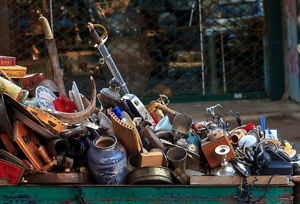
Vintage and Antiques
 "One man’s trash is another man’s treasure, " or so we are told. As this adage implies, word choice when describing an item can sometimes be subjective, and the item's value is often relative to the worth placed on it by an individual. With the value of an item being so variable, then, it is important to come to some common understanding of the standard meaning attached to basic labels.
"One man’s trash is another man’s treasure, " or so we are told. As this adage implies, word choice when describing an item can sometimes be subjective, and the item's value is often relative to the worth placed on it by an individual. With the value of an item being so variable, then, it is important to come to some common understanding of the standard meaning attached to basic labels.
Whether hunting at the antique shop for enjoyment, or surfing listings for just the right item, understanding what is meant by terms such as "antique" or "vintage" will improve the buying and selling process.
These terms join a host of others (e.g. retro, classic, etc.) that have come to be understood as simply meaning "old." Often, such words are used to imply that it is from another production era and cannot be purchased new today. "Old" is good, as many people seek items with histories attached to them, whether real or imagined, or some standard of quality or style that only truly existed during a certain era. But just being old does not make an item an "antique" or "vintage."
These terms are so frequently used interchangeably with "old, " that many people do not even know that the words do have more formally, and in some cases, more legally, accepted meanings.
Defining Terms
While both terms, "antique" and "vintage, " do muster connotations of "old, " understanding the specific meanings that people knowledgeable about the trade attach to these words will go a long way toward clearer communication.
It is important to note that, for some specific items, like firearms and some clothing items, there are standardly accepted definitions of these terms that may differ from those discussed here. In fact, for firearms in particular, the word "antique" is very specific, and there are certain laws about the buying and selling of firearms based on whether they meet specific qualification. Specific guides for items provide information on the use of terminology within an individual category.
Antique
Today, everything seems to be an antique. The 1980s brick cell phone and a craftsman-style table, handcrafted during the depression are each slapped with the same "antique" label that a 1800’s era family heirloom quilt justly deserves. For those in the trade, however, this word does not just mean "old, " but signifies a minimum specific age and should not be applied to the ‘80s brick cell phone and, perhaps, not even to the depression-era handcrafted table.
The Antiques Roadshow must regularly decide what is and what is not an antique. According to them, an "antique" is, "[g]enerally speaking, an object of considerable age valued for its aesthetic or historical significance. In the antiques trade, the term refers to objects more than 100 years old."
Thus, when buying or selling an item labeled "antique, " trade standards suggest that the term should be reserved only for items greater than 100 years old. Outside of the practice of buying and selling items, however, use of the word "antique" can be understood to attach no specific age to an item.
Even inside the trade, though, there is some variability as to the exact age that signifies an antique. Generally speaking, it is safe to stick with the 100 year definition, but some hold to an 80 year marker. The 80 year marker considers the heritage of the item in that it reflects the span of two generations, with one generation traditionally considered to be the length of 40 years.
These are all simply trade standards, but it should also be noted that U.S. Customs has set their own legal definition of an antique, and it is in agreement with the 100 year guideline. U.S. Customs also adds a quality standard to their definition in that, while it is acceptable to repair or restore an antique, the item must retain its original character and be less than 50% restored to be considered an antique.
In keeping with these standards, let’s examine the three items discussed above. The brick cell phone from the 80s, while being the oldest cell phone produced, could not be considered an antique for 70 more years. Likewise, as odd as it seems, that depression era, handcrafted table is, as yet, a few years shy of acquiring a true antique status. Indeed, of the three, only the heirloom quilt from the 1800’s is a true antique.
Vintage
Even if they may not be aware of what the standard is, many people realize that there is some standard for defining an antique. Many people speculate that if an item is not antique it must be at least be "vintage." Sometimes this is the case, but not always. Often, it is all in the wording.









